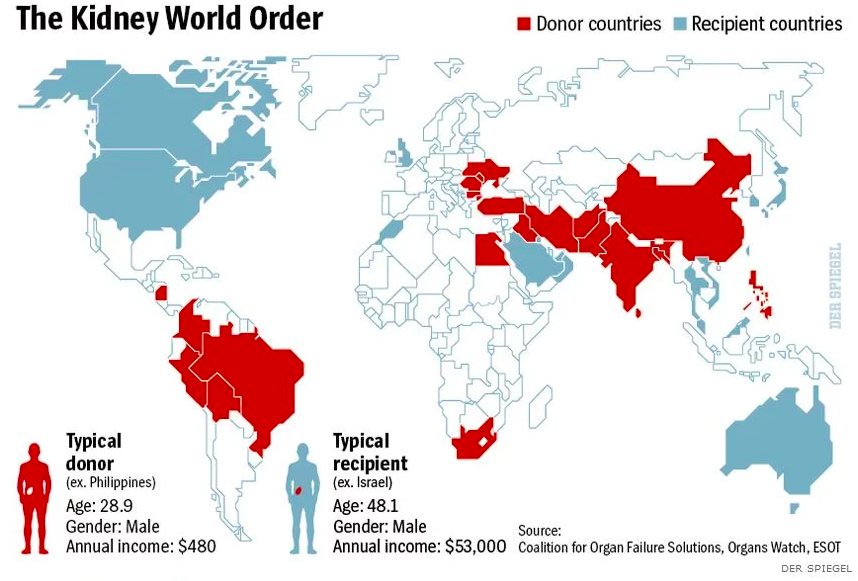Introduction
Organ trafficking is a problem that has been overlooked for decades, which led to the worsening of the situation. Kidneys and the liver are the two most commonly traded organs; the trading is differentiated into three categories that describe the nature of cases. The first category of illegal trade of organs is characterized by victims being deceived or forced to give up an organ, the second category is associated with the donor giving formal o informal agreement to give up an organ; however, they are usually cheated because they either receive no payment or get paid significantly less than promised initially. The third category of organ trafficking is the most alarming because it deals with vulnerable populations, such as homeless, immigrants, those below the poverty line, and so on. These people are usually get treated for the medical condition that does not exist, with organs being taken out without their consent to it (Scutti, 2013).
Organ Trafficking Statistics
With regards to the statistics of organ trade, Campbell and Davidson (2012) from the Guardian reported that the illegal trade of kidneys “has risen to such a level than an estimated 10,000 black market operations involving purchased human organs now take place annually, or more than one an hour” (para. 1). This evidence points to the fact that traffickers do everything in their power to ignore the laws and deceit the vulnerable and the desperate to give up their organs. Importantly, patients who require organ transplants my pay up to $200,000 for making sure that traffickers find the necessary organ for them (Tomlinson, 2015).
Traffickers, in return, can pay their victims as little as $5,000, which is nothing in comparison with the money that those in need of organs pay. It is also important to note that the average organ donor in the trafficking industry is around thirty years old and has an annual income of five hundred dollars while the average recipient is forty-eight and has an annual income of fifty-three thousand dollars (see Figure 1). This shows a massive income gap between those who agree to give up an organ and those desperate enough to pay for an illegal transplant. However, due to the illegal nature of such operations, donor organs cannot guarantee to work, and in fact, many fail after the transplant (Castillo, 2014).

Causes of Trafficking
It is essential to understand that the surge in organ trafficking has been fuelled by the increasing demand for organs associated with diseases such as diabetes. Since the waiting list for legal organ transplantations is extremely long, many patients die without getting their transplant. Therefore, the black market is attractive to wealthy patients who can afford the high prices on illegal donors and are ready to pay them to restore their health. There is an issue of morality that lies deep in the organ trafficking industry: those who agree giving up their organs do not get paid enough are forced to suffer through the operation that can take place in unsanitary conditions. Immediate action is needed to prevent illegal organ trafficking and establish a system that could address the needs of recipients without undermining the integrity of donors.
Solutions and Conclusions
It has been estimated that only ten percent of the global organ transplantation needs are met. The key suggestion provided to eliminate the black organ market is creating legal markets for those organs that are high in demand worldwide. On the other hand, the creation of legal markets can expand the black trade due to the openness of operations. Such legislation as the Declaration of Istanbul on organ trafficking and transplant tourism are now supported by the World Health Organization. It is believed that the best solution for overcoming trafficking is associated with the following four points:
- The development of improved legal systems of organ donations from deceased patients;
- The encouragement of voluntary (altruistic) donation of kidneys within the healthy population;
- The preventions of needs for transplantation through the treatment of conditions that lead to organ failure, with hepatitis and diabetes being the most common;
- The implementation of state laws that ban organ trafficking and trading (“Action to stop thriving global organ trade must start at home,” 2012).
In order for countries worldwide to achieve the goals mentioned above, separate countries should make themselves responsible for catering to the population’s transplant needs through ensuring independence and self-sufficiency. Patient education is required to inform possible donors about the benefits of legal organ donations as well as spread awareness of the extreme poverty in countries where citizens are willing to give up their organs for extremely low compensation. The lack of education and awareness of the problems that persist in the sphere of organ transplantation fuel the black trade and make it impossible for countries to address the issue of trafficking. Self-sufficiency and self-education are key in overcoming organ trafficking; however, the international community can also address the problem through economically helping countries where organ trafficking has become the only way to earn money.
References
Action to stop thriving global organ trade must start at home. (2012). Web.
Campbell, D., & Davison, N. (2012). Illegal kidney trade booms as new organ is ‘sold every hour.’ The Guardian. Web.
Castillo, J. (2014). 25 alarming facts about organ trafficking. Web.
Scutti, S. (2013). Organ trafficking: An international crime infrequently punished. Web.
The kidney world order [Image]. (2013). Web.
Tomlinson, S. (2015). Inside the illegal hospitals performing thousands of black market organ transplants every year for $200,000 a time. Web.